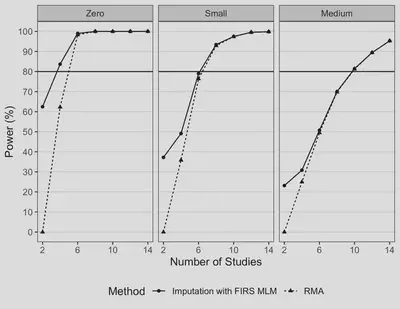Jointly modeling participant-level data and summary statistics for treatment differences
Cumulative data analysts typically rely on two statistical frameworks: meta-analysis (MA) and integrative data analysis (IDA; Curran et al., 2009). MA analyzes aggregate data (AD, i.e., summary statistics) whereas IDA analyzes individual participant data (IPD). In practice, it is possible that AD are available from some studies whereas IPD are available from others. Recently, two-stage and one-stage multilevel modeling (MLM) approaches have been developed and applied in medical research (e.g., Riley et al., 2008; Papadimitropoulou et al., 2019) to pool AD and IPD. Although jointly modeling AD and IPD may allow for more generalizable and precise estimates, these models remain surprisingly unused in psychological science. Furthermore, analytical examination and small-sample simulation study to evaluate the performance of these models is limited.
We conducted a simulation study to evaluate twelve methods (see Figure 1) for cumulative analysis of treatment differences when (a) only AD, (b) only IPD, and (c) both AD and IPD are available. With only AD, we considered (1) random-effects MA (RMA) and the pseudo-IPD imputation strategy of Papadimitropoulou et al. (2019) with (2) a fixed-intercepts random-slopes (FIRS) MLM, (3) an empirically reference-group mean-centered (RGMC) MLM, and (4) a random-intercepts random-slopes (RIRS) MLM. With only IPD, we considered (1) a FIRS MLM, (2) a RGMC MLM, and (3) a RIRS MLM. With both AD and IPD, we considered (1) the RGMC MLM, (2) the Riley et al. (2008) MLM, and the pseudo-IPD imputation strategy with (3) a FIRS MLM, (4) a RGMC MLM, and (5) a RIRS MLM.
To evaluate the estimation accuracy, type I error rate, and power of these approaches with 2-40 AD and/or IPD studies, we generated data from a RIRS MLM for treatment differences with a dichotomous predictor (X, coded zero for the reference group and one for the treatment group) and a normally distributed outcome Y,
Simulation results are summarized in Figure 1. Estimates of
Despite these cases of biased estimates of
Generally, these results suggest that modeling all available data can improve the estimation precision for
This study introduces novel methods for jointly modeling AD and IPD to psychologists and is the first simulation study to compare these methods. Our results suggest that under correct model specification these models can accurately estimate treatment effects and between-study heterogeneity with AD and/or IPD and improve power by pooling all available data. When both IPD and AD are available, we recommend the Riley et al. (2008) MLM if imputation of pseudo-IPD is not performed. Otherwise, we suggest fitting the FIRS MLM to IPD along with imputed pseudo-IPD if there are available AD studies. When only AD are available, we suggest imputing pseudo-IPD and analyzing it with the FIRS MLM instead of the usual RMA. If covariates are available, we can extend these methods to estimate and test both participant-level and treatment-covariate moderation effects using IPD only or both IPD and AD.
Figure 2. Power Comparison with AD Only for RMA vs. FIRS MLM with Imputed Pseduo-IPD for Testing a “Medium” Average Treatment Effect.

References
Curran, P. J., & Hussong, A. M. (2009). Integrative data analysis: The simultaneous analysis of multiple data sets. Psychological Methods, 14(2), 81–100. https://doi.org/10.1037/a0015914
Papadimitropoulou, K., Stijnen, T., Dekkers, O. M., & Cessie, S. le. (2019). One-stage random effects meta-analysis using linear mixed models for aggregate continuous outcome data. Research Synthesis Methods, 10(3), 360–375. https://doi.org/10.1002/jrsm.1331
Riley, R. D., Lambert, P. C., Staessen, J. A., Wang, J., Gueyffier, F., Thijs, L., & Boutitie, F. (2008). Meta-analysis of continuous outcomes combining individual patient data and aggregate data. Statistics in Medicine, 27(11), 1870–1893. https://doi.org/10.1002/sim.3165